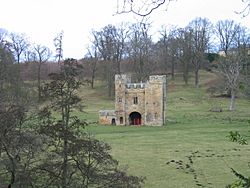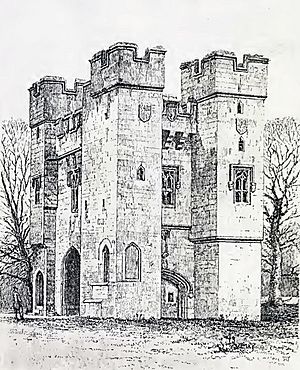Alnwick Abbey facts for kids

Alnwick Abbey gatehouse
|
|
| Monastery information | |
|---|---|
| Order | Premonstratensian |
| Established | 1147 |
| Disestablished | 1539 |
| Mother house | St Mary and St. Martial at Newsham |
| People | |
| Founder(s) | Eustace fitz John |
| Site | |
| Location | Alnwick |
Alnwick Abbey was a special kind of monastery called a Premonstratensian abbey. It was started in 1147 by a man named Eustace fitz John. The abbey was built near Alnwick, England, close to the River Aln. It was like a "daughter house" to Newhouse Abbey in Lincolnshire.
The abbey was closed down in 1535, then reopened briefly in 1536, and finally closed for good in 1539. Today, the only part you can still see is its amazing 14th-century gatehouse. This gatehouse is a very important historic building.
Contents
How Alnwick Abbey Started
Eustace fitz John became the lord of Alnwick when he married Beatrix. She was the daughter of a man named Ivo de Vesci. Eustace gave a lot of land and money to help start the abbey.
The official paper that created the abbey was sent to William of St. Barbara, who was the Bishop of Durham. It mentioned that the abbey was built to honor many people, including Ivo de Vesci. The first Premonstratensian monks came to Alnwick in 1147.
This order of monks first arrived in England in 1143. They settled at Newhouse in Lincolnshire. The Premonstratensians followed rules similar to the "Rule of St. Augustine." They also valued a simple life and quiet places, like the Cistercian monks. That is why they built their monasteries in rural areas.
Alnwick Abbey also looked after other places. These included a hospital in Alnwick and Guyzance Priory. Guyzance Priory was joined to Alnwick Abbey by Eustace fitz John.
A Big Party in the 1300s
Imagine a huge feast at the abbey! A special book from the abbey tells us about a banquet held in 1376. The abbot, Walter de Hepescotes, hosted this party. It was on the day of the Assumption of the Blessed Virgin Mary.
The main guests were Henry, the 4th Lord of Alnwick, and thirteen knights. Many other important people from the area also attended. About 120 guests ate in the refectory, which was the monks' dining hall. Then, another 86 people had a second meal.
Even more people were fed outside! The cloisters, which are covered walkways, were filled with 1,020 common people of all ages. They were also given a feast. It must have been quite a sight!
Important People Buried Here
Many members of the powerful House of Percy family were buried at Alnwick Abbey.
- Henry, the second Lord of Alnwick, who died around 1351.
- Henry, the third Lord, who gave the monks a lot of money when he died in 1368.
- Mary, his wife, who was the daughter of Henry, 3rd Earl of Lancaster.
In 1372, Henry, the fourth Lord of Alnwick, became part of the abbey's brotherhood. Many other knights and squires joined him. The next year, his eldest son, Henry "Hotspur", and his two brothers, Sir Thomas and Sir Ralph, also joined.
Other Burials at the Abbey
- John de Vesci
- Eustace de Vesci
- William de Vesci and his wife Burga de Stuteville
- Henry Percy, 1st Earl of Northumberland
- Mary of Lancaster
Hard Times: Famine and Sickness
During the time Walter de Hepescotes was abbot, the abbey faced very difficult times. There was a great shortage of food. Also, a terrible sickness, like a pestilence, hit the area. This sickness sadly killed all the cattle that belonged to the monastery.
The Abbey's Role in Parliament
The abbot of Alnwick Abbey was sometimes called to attend the parliaments of England. This happened during the reign of King Edward I several times. The abbot was also called to a parliament held in Carlisle and to one during the reign of King Edward II. This shows that the abbey and its leaders were important figures in society.
The Abbey Closes Down
In 1539, during the Dissolution of the Monasteries, Alnwick Abbey was closed for good. This was a time when many monasteries in England were shut down by the King. At that time, the abbey had thirteen monks.
Later, King Edward VI gave the abbey's land to Ralph Sadler and Laurence Winnington. After that, it was owned by the Brandling family and the Doubledays.
In 1617, Francis Brandling welcomed King James to Alnwick Abbey. The King stayed for two nights while traveling to Scotland.
The Famous Gatehouse and Tower
Today, the only parts of Alnwick Abbey that remain are its impressive gatehouse and a tower. These buildings are much newer than the original abbey. You can see this from their architecture and the coats of arms carved on them.
The tower is not square but oblong. It has a small lookout turret on each corner. On the north side, there is a decorated niche that probably held a statue of the Virgin Mary. Below it, there is a carving of an angel. Above the entrance are shields with coats of arms, including a cross that might belong to the Vesci family.
On the south side, there is a niche with a figure of a monk from the Premonstratensian order. This carving is still in good condition. This side also has shields with the arms of Brabant (used by the Percys) and the arms of the Lucy family.
There is also a gate on the east side. It has carvings of cherubs holding shields. This entrance also has a niche for a statue. Both the north and east entrances had "machicolations." These were openings from which defenders could drop things on attackers. The stone work of this tower is excellent. The old iron-braced gates are still there.
Above the gate leading into the abbey's courtyard, there is a white marble shield. It is worn by the weather but still shows the crest of the Doubleday family. This crest shows an arm in armor holding a mullet (a star shape).
The gatehouse is a very important historical site and is protected as a Scheduled Ancient Monument.
Abbots of Alnwick Abbey
|
|
Alnwick Abbey in Movies
The historic Gatehouse of Alnwick Abbey can be seen in the opening scenes of the 1998 film Elizabeth.


